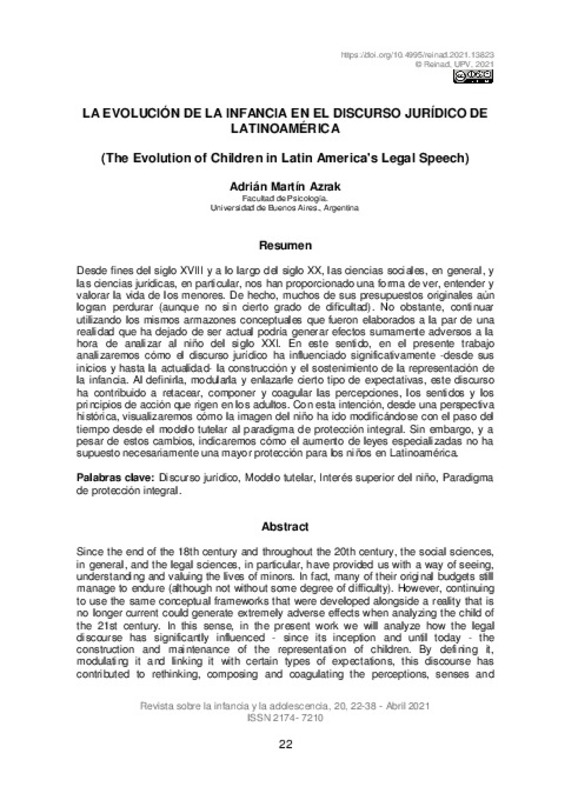|
Resumen:
|
[EN] Since the end of the 18th century and throughout the 20th century, the social sciences, in general, and the legal sciences, in particular, have provided us with a way of seeing, understanding and valuing the lives of ...[+]
[EN] Since the end of the 18th century and throughout the 20th century, the social sciences, in general, and the legal sciences, in particular, have provided us with a way of seeing, understanding and valuing the lives of minors. In fact, many of their original budgets still manage to endure (although not without some degree of difficulty). However, continuing to use the same conceptual frameworks that were developed alongside a reality that is no longer current could generate extremely adverse effects when analyzing the child of the 21st century. In this sense, in the present work we will analyze how the legal discourse has significantly influenced - since its inception and until today - the construction and maintenance of the representation of children. By defining it, modulating it and linking it with certain types of expectations, this discourse has contributed to rethinking, composing and coagulating the perceptions, senses and principles of action that govern adults. With this intention, from a historical perspective, we will visualize how the image of the child has been modified over time from the tutelary model to the paradigm of comprehensive protection. However, and despite these changes, we will indicate how the increase in specialized laws has not necessarily meant greater protection for children in Latin America.
[-]
[ES] Desde fines del siglo XVIII y a lo largo del siglo XX, las ciencias sociales, en general, y las ciencias jurídicas, en particular, nos han proporcionado una forma de ver, entender y valorar la vida de los menores. De ...[+]
[ES] Desde fines del siglo XVIII y a lo largo del siglo XX, las ciencias sociales, en general, y las ciencias jurídicas, en particular, nos han proporcionado una forma de ver, entender y valorar la vida de los menores. De hecho, muchos de sus presupuestos originales aún logran perdurar (aunque no sin cierto grado de dificultad). No obstante, continuar utilizando los mismos armazones conceptuales que fueron elaborados a la par de una realidad que ha dejado de ser actual podría generar efectos sumamente adversos a la hora de analizar al niño del siglo XXI. En este sentido, en el presente trabajo analizaremos cómo el discurso jurídico ha influenciado significativamente -desde sus inicios y hasta la actualidad- la construcción y el sostenimiento de la representación de la infancia. Al definirla, modularla y enlazarle cierto tipo de expectativas, este discurso ha contribuido a retacear, componer y coagular las percepciones, los sentidos y los principios de acción que rigen en los adultos. Con esta intención, desde una perspectiva histórica, visualizaremos cómo la imagen del niño ha ido modificándose con el paso del tiempo desde el modelo tutelar al paradigma de protección integral. Sin embargo, y a pesar de estos cambios, indicaremos cómo el aumento de leyes especializadas no ha supuesto necesariamente una mayor protección para los niños en Latinoamérica.
[-]
|








